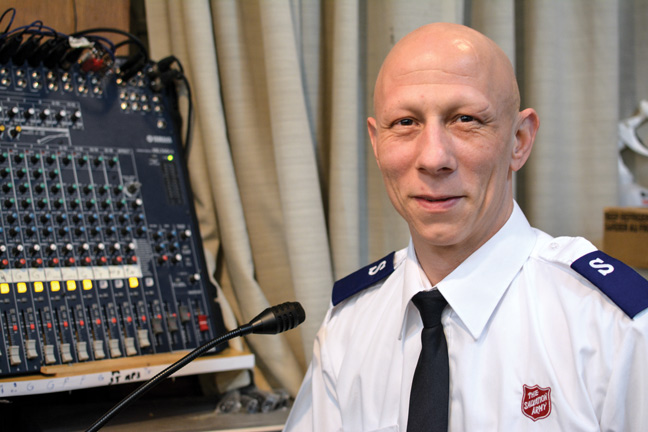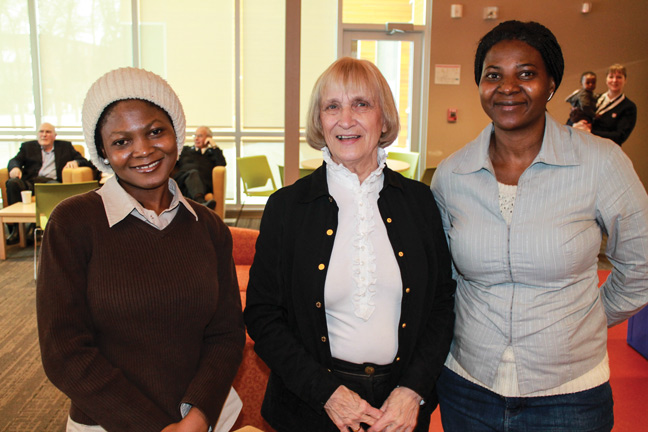“I hated God,” he recalls. “I was my own god. I didn't need anybody.”
That changed when Ricard came to The Salvation Army's Booth Centre last spring. He had stayed at the centre before, but this time it was different.
“Therapy never worked for me, because I always had something missing,” he says.
That missing piece was a relationship with God. Curious about faith, Ricard started attending Le Phare, a new church plant that operates out of the centre. With its friendly atmosphere and come-as-you-are approach, Le Phare was just the right place for Ricard.
“My experience here has been wonderful,” he says. “It has changed everything in my life.”
Challenges and Opportunities
The Salvation Army currently has 314 churches in Canada and Bermuda, but at one point each of them was an outpost or a church plant. Le Phare (meaning “lighthouse”) is one of three Army church plants in the territory today; other plants include Living Hope Community Church in Winnipeg and South Shore Corps in Saint-Hubert, Que.
Church planters face a number of challenges when starting out. Some are practical: Where will the church meet? How will it support itself? But in 2014, planters are coming up against broader societal trends. While nearly 70 percent of the Canadian population identify as Christian, 24 percent have no religious affiliation, up from 15 percent just 10 years ago.
“An increasing number of the population don't have much in the way of Christian memory,” says James Watson, territorial consultant for church planting and congregational revitalization. “People have heard in the media about residential schools and high-profile child abuse cases involving religious groups. People have questions. Is Christianity OK? Is this a step I want to take?”
But Watson believes that church planting offers an opportunity to reach out to people in a unique way.
“You can ask, what are the elements of a church that would be very welcoming to someone who's not comfortable with their understanding of church?” Watson says. “There is a lot of relationship-building that needs to happen.”
In this context, he believes The Salvation Army is well poised to reach out to people who are skeptical of Christianity because the Army is known for helping others. “The Army has so many people who are actively engaged in serving their community,” Watson says. “They live a very attractive life of faith.”
Making Soldiers
With community engagement being key to the success of a church plant, the Army has paired Le Phare with the Booth Centre, a 207-bed residence for men facing addictions, mental health issues or homelessness.
“It's a long-range partnership that benefits both Le Phare and the centre,” says Watson. “It has a community presence that helps people who are coming through the Booth Centre, but it also has a church for people who are excited about their faith and want a place to serve.”
My experience at Le Phare has been wonderful. It has changed everything in my life.
Le Phare, which officially opened in February 2013, grew out of the centre's chaplaincy program.
“The chaplain voiced a frustration that, when the men left the centre, he usually lost contact with them,” says Captain Betty Lessard, community ministries officer at the Booth Centre and corps officer at Le Phare. “They didn't have a church home to go back to, and it's difficult for a lot of our men to integrate into other churches. We understand their experiences, their challenges and they've built relationships here.”
The idea of creating a new corps came from a graduate of the centre's addictions program who wanted to become part of The Salvation Army.
“This man kept asking why he couldn't become a soldier,” says Captain Lessard. “The short answer was that the Booth Centre was not a corps.”
Since becoming a corps, Le Phare has enrolled three adherents and four soldiers, including Ricard. Approximately 40 people attend their Sunday evening service and 10 people attend their Tuesday prayer meeting.
“I come to Le Phare for the teaching,” says Ricard, who works the soundboard every Sunday. “I get a feeling of peace inside because I'm listening to someone who finally says something that makes sense to me.”
Most of Le Phare's congregation live at the Booth Centre, but the corps is expanding its reach into the nearby neighbourhood of Hochelaga-Maisonneuve. The corps holds two food distribution runs in this disadvantaged area each month, as well as a monthly breakfast which serves around 50 people.
“The most exciting thing has been to see the men involved in the church give themselves to serve God,” says Captain Lessard. “We have an artist, musicians, a PowerPoint expert, a technical genius, a chef and others with the gift of service. It's a joy to watch them work together!”
Being in partnership with the Booth Centre has proven enormously helpful to Le Phare as it serves its unique community. “We're a different kind of corps,” says Captain Lessard. “We have people with addictions, mental health issues, behavioural problems and, thanks to the Booth Centre, we have expert in-house advice. It's such a blessing.”
 Stéphane Ricard operates the sound system at Montreal's Le Phare Corps (Photo: Anton Uvarov)
Stéphane Ricard operates the sound system at Montreal's Le Phare Corps (Photo: Anton Uvarov)
Part of the Family
As with Le Phare, Living Hope Community Church is partnered with a social services centre, but in a very different context. Living Hope operates out of Winnipeg's Barbara Mitchell Family Resource Centre, located in St. Vital, a high-density neighbourhood with many younger families and a large immigrant population.
When the centre's new building opened two years ago, it did not have a chaplain and the leadership recognized that the centre needed a spiritual component.
“The Barbara Mitchell centre and Living Hope church fit together really well,” says Captain Corinne Cameron, the centre's executive director. “Through the social ministry of the centre we have many points of contact into our building, and for those who are spiritually seeking we are able to connect them with the church.”
Living Hope launched in September 2013, but Captain Steven Cameron, corps officer, began laying the groundwork months in advance, working as a volunteer at the centre.
“Our goal wasn't to go out and bombard the community with advertisements that the church was there, but to work with people who were already involved with the centre,” Captain Steven Cameron explains.
As well as building relationships at the centre before Living Hope officially opened, the corps also performed community service, gave out cold treats on hot summer days in a nearby park and held a community carnival.
Living Hope is a mix of Salvationists and newcomers, with about two-thirds of the congregation coming from the former Winnipeg East Corps, which closed last August.
“We're a unique Salvation Army plant in that we've had a blended style right from the beginning,” says Captain Steven Cameron. “There is a contemporary component, but there's also traditional Salvation Army attributes to the congregation.” The corps has a band and a songsters group, as well as a thriving seniors' program and a kids' club called Music in Motion. Led by cadets from Winnipeg's College for Officer Training, “M&M” teaches children from the corps and community how to play instruments.
Approximately 90 people attend church at Living Hope on Sunday mornings, and just about everyone who attends is also involved with the Barbara Mitchell centre—if not before, then after they started coming to the corps.
Adenike Omotayo immigrated to Canada from Nigeria in October 2013 with her husband, sister and three children. Arriving in Winnipeg with little money and no support system, Omotayo was in need of practical assistance.
“A neighbour of mine told me that the Barbara Mitchell centre had a food bank, so I came to The Salvation Army to book an appointment,” she says. Captain Corinne Cameron was on hand to support her as she registered for assistance.
“She was so patient with me and she took the pains upon herself to help me,” says Omotayo. “I was shocked. This was a person who didn't know me from anywhere, and she would just do this. I knew that God was truly here. That's why I come to The Salvation Army.”
She started attending Living Hope with her family the next Sunday and was impressed with how friendly the community was. “Old and young, black and white, there is no segregation. We are all one.”
Omotayo's family is deeply involved with both the church and the centre. Omotayo attends the English Café language program and Family Foundations group for expecting parents and parents with newborns, while her children attend programs throughout the week.
“For us to be at The Salvation Army is not a mistake,” she reflects. “It is ordained by God for us to be here, to be part of the family.”
 Olabisi Odawobi-Senuga, Denise Lee and Adenike Omotayo enjoy coffee hour after a service at Winnipeg's Living Hope CC
Olabisi Odawobi-Senuga, Denise Lee and Adenike Omotayo enjoy coffee hour after a service at Winnipeg's Living Hope CC










Leave a Comment